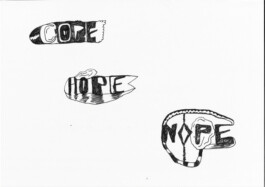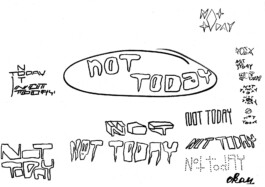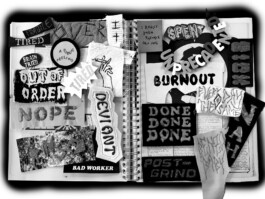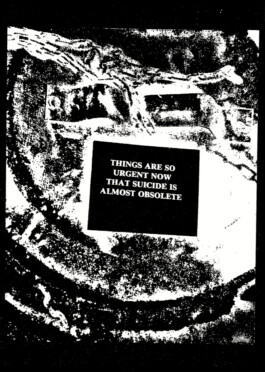14
Mental Hellth Dumpster Fire
Jess Henderson
contemplate, rummage, decelerate
DIY, burnt out, hyper
clothing, mental health, maximalism

Jess Henderson, Coping Fella (2021)
On Language as Device and Medium
The story and concept for the work titled Mental Hellth Dumpster Fire (2023) begins in the Living Museum Ateliers that are part of Psychiatry St. Gallen’s grounds in Wil, Switzerland. Arranged by ZHdK’s ‘Artists in Labs’ programme, I spent a semester in residency at the Living Museum for the purposes of research on burnout and artistic production. The project I worked on at the Living Museum began with the theme of boundaries. Boundaries is a key word that came up again and again in my conversations and discussions with people on my primary research topic of burnout. Essentially, one learns that the setting of boundaries (in all aspects of life) and learning how to assert and protect them is non-negotiable. As I took this to Wil as my starting point, I had also been thinking about the voicing of boundaries. How hard it can be to do, how great it would be to communicate them without needing to do that verbally, thus avoiding the inherent labour that comes with that.
Sharing these thoughts with Dr. Ottiger, I told her how some days I wish I had the words ‘NOT TODAY’ emblazoned across my front. We discussed the embodiment of these feelings, and the way that clothes are a sort of boundary upon the body. A barrier between ourselves and the world. A simultaneous means of expression. I began chatting with the artists I was working alongside each morning, asking about how they were feeling and what they would like to express to the world that day. This became the practice; I would take their anecdotes and wishes (as well as my own) and create band merch-style patches that could be worn on the body. Each one had its own materialisation, different styles, always experimenting with application and formal techniques, scavenging for scraps and unexpected materials around the building. We would take turns wearing them, enjoying the reactions and provocations the patches produced. Once I had made a lot, we had a resource to pick from depending on how we felt that morning. The joke became ‘Hmmm, so how do I want to tell the world to fuck off today?’

Jess Henderson, Not Todays (2023)
These crowd-sourced words and band patch-style applications initiated during my time at the Living Museum would result in the artwork shown as part of the MTR annual exhibition and counterpart of my graduation project. The work titled Mental Hellth Dumpster Fire is a worker-style jacket (emblematic of the labour politics and contemporary conditions of making a living related to burnout that the artwork critiques) covered in patches with different words and texts on them executed in a range of materialisations and techniques. It makes commentary on a contemporary mood of exhaustion and the mass experience of deteriorating mental health on varying scales, situated in a post-pandemic world still characterised by ‘overworked and underpaid’ and scarred by the period of intense isolation. Here I provide description and analysis of textual, aesthetic, and formal, qualities, and decisions of the work.

The final piece incorporates some of the patches made during the Living Museum residency, as well ones made as a continuation from this period (sample pictured above) for which I drew upon an eclectic array of sources including, but not limited to; song lyrics (e.g. Lil Wayne’s ‘I’m ill, not sick’,) theoretical references (Cvetkovich’s ‘A Public Feeling’,) idioms (RUNNING ON EMPTY), anecdotes from interviews (‘I feel better when I cry’,) pop culture references (‘Tired & Wired’ from a regular column in 90’s era Wired magazine,) references to the pharmaceutical industry (BENZO BABY,) slogans (PATHOLOGISE EVERYTHING,) colloquialisms (GET OFF MY DXCK,) wordplays (REST LESS,) and the isolation or emphasis of singular words (JADED.) What results is a mish-mash of source points, ‘inside jokes,’ and Holzer Truism-esque statements that present a certain feeling or experience of life based upon my research thus far. All are made and written by hand, spanning paints and embroideries, to applique and cut out/stick on, using found and new materials.
The impression is simultaneously a multitude of voices and a sense of universality—both with an evacuation of the singular author. Anonymous and genderless speakers sing in chorus whilst creating a visual cacophony. The jacket becomes overwhelmed with the amount of patches, mirroring the status of the overwhelmed subject and a far cry from the normal one or two band patches that would be applied. With lettering chiefly handwritten rather than computer generated, each one feels nearby and impassioned. The intention of this work is not an authorisation for the aesthetic status of the texts, but rather rhetorical heterogeneity. And with this, the work submits to extreme forms of dislocation and pluralisation; it is impossible to know who is saying these things, where they are coming from, etc. I can attribute this attitude towards the intersection of language and authorship in part to gender. Feminist artists have been working since the 1970’s to go against the tendency of male artists before them who felt that the discourse they produced belonged to them both legally and culturally. These womxn understood that the ‘possession’ of language is profoundly gender privileged and, as we understand more now, of a colonial mindset. These same feminist artists (think not only Holzer but Barbara Kruger or Cindy Sherman for instance) introduced an expertise in dealing with and merging theoretical concerns, an ease with pop culture, and implicit politics within their art.
The unidentifiability, undecidability, or pluralisation of the authorial voice allows for contradiction, as well as an awareness of being an entangled subject and part of the systems and ideologies that are being critiqued. Not outside of society, culture, institutions or political concerns, but embedded within them. These voices come from everywhere and nowhere, both uncannily personal and sometimes rigidly prescriptive.

Jenny Holzer, ‘Survival’ Series Sticker (1983),
scanned and edited (2023)
I once read that Jenny Holzer chose to write her Truisms (and many of her successive texts) in all capital letters because of how it has a universalising effect, later realising that my choice of all-caps was producing the same consequence. Besides handwriting and capitalisation, this work uses the structural device of ellipsis: the texts leave out a great deal of information and do not answer all of the questions the viewer/reader might reasonably pose (as mentioned earlier.) What is the context of what is being presented? Who are the people speaking, acting, and being described? What was the exact sequence of events here? This indeterminacy is deliberate and, rather than an oversight, a fundamental technique for generating meaning. In being intentionally anonymous and genderless, it calls the viewer into question over ‘does it really matter?’ Time is not conceived as a continual flow, but rather as a constellation of present moments. It feels urgent and irreducibly now. The subject matter is the figure (experience of burnout) and ground (factors of the environment) and the tone of voice is matter-of-fact, vulnerable, irritable and exhausted, sometimes desperate, other times bored of it, whilst somehow remaining funny and using triviality to make a not-funny situation laughable. Artistic formal strategies are deployed to make use of contemporary popular and much-loved punk/DIY aesthetics to convey content of social, cultural, and political criticism. The result is a timely and politicised commentary on the topic of burnout and the social questions and dilemmas it poses, in the form of an overloaded worker jacket.
Mental Hellth Dumpster Fire
Jess Henderson
contemplate, rummage, decelerate
DIY, burnt out, hyper
clothing, mental health, maximalism

Jess Henderson, Coping Fella (2021)
On Language as Device and Medium
The story and concept for the work titled Mental Hellth Dumpster Fire (2023) begins in the Living Museum Ateliers that are part of Psychiatry St. Gallen’s grounds in Wil, Switzerland. Arranged by ZHdK’s ‘Artists in Labs’ programme, I spent a semester in residency at the Living Museum for the purposes of research on burnout and artistic production. The project I worked on at the Living Museum began with the theme of boundaries. Boundaries is a key word that came up again and again in my conversations and discussions with people on my primary research topic of burnout. Essentially, one learns that the setting of boundaries (in all aspects of life) and learning how to assert and protect them is non-negotiable. As I took this to Wil as my starting point, I had also been thinking about the voicing of boundaries. How hard it can be to do, how great it would be to communicate them without needing to do that verbally, thus avoiding the inherent labour that comes with that.
Sharing these thoughts with Dr. Ottiger, I told her how some days I wish I had the words ‘NOT TODAY’ emblazoned across my front. We discussed the embodiment of these feelings, and the way that clothes are a sort of boundary upon the body. A barrier between ourselves and the world. A simultaneous means of expression. I began chatting with the artists I was working alongside each morning, asking about how they were feeling and what they would like to express to the world that day. This became the practice; I would take their anecdotes and wishes (as well as my own) and create band merch-style patches that could be worn on the body. Each one had its own materialisation, different styles, always experimenting with application and formal techniques, scavenging for scraps and unexpected materials around the building. We would take turns wearing them, enjoying the reactions and provocations the patches produced. Once I had made a lot, we had a resource to pick from depending on how we felt that morning. The joke became ‘Hmmm, so how do I want to tell the world to fuck off today?’

Jess Henderson, Not Todays (2023)
These crowd-sourced words and band patch-style applications initiated during my time at the Living Museum would result in the artwork shown as part of the MTR annual exhibition and counterpart of my graduation project. The work titled Mental Hellth Dumpster Fire is a worker-style jacket (emblematic of the labour politics and contemporary conditions of making a living related to burnout that the artwork critiques) covered in patches with different words and texts on them executed in a range of materialisations and techniques. It makes commentary on a contemporary mood of exhaustion and the mass experience of deteriorating mental health on varying scales, situated in a post-pandemic world still characterised by ‘overworked and underpaid’ and scarred by the period of intense isolation. Here I provide description and analysis of textual, aesthetic, and formal, qualities, and decisions of the work.

The final piece incorporates some of the patches made during the Living Museum residency, as well ones made as a continuation from this period (sample pictured above) for which I drew upon an eclectic array of sources including, but not limited to; song lyrics (e.g. Lil Wayne’s ‘I’m ill, not sick’,) theoretical references (Cvetkovich’s ‘A Public Feeling’,) idioms (RUNNING ON EMPTY), anecdotes from interviews (‘I feel better when I cry’,) pop culture references (‘Tired & Wired’ from a regular column in 90’s era Wired magazine,) references to the pharmaceutical industry (BENZO BABY,) slogans (PATHOLOGISE EVERYTHING,) colloquialisms (GET OFF MY DXCK,) wordplays (REST LESS,) and the isolation or emphasis of singular words (JADED.) What results is a mish-mash of source points, ‘inside jokes,’ and Holzer Truism-esque statements that present a certain feeling or experience of life based upon my research thus far. All are made and written by hand, spanning paints and embroideries, to applique and cut out/stick on, using found and new materials.
The impression is simultaneously a multitude of voices and a sense of universality—both with an evacuation of the singular author. Anonymous and genderless speakers sing in chorus whilst creating a visual cacophony. The jacket becomes overwhelmed with the amount of patches, mirroring the status of the overwhelmed subject and a far cry from the normal one or two band patches that would be applied. With lettering chiefly handwritten rather than computer generated, each one feels nearby and impassioned. The intention of this work is not an authorisation for the aesthetic status of the texts, but rather rhetorical heterogeneity. And with this, the work submits to extreme forms of dislocation and pluralisation; it is impossible to know who is saying these things, where they are coming from, etc. I can attribute this attitude towards the intersection of language and authorship in part to gender. Feminist artists have been working since the 1970’s to go against the tendency of male artists before them who felt that the discourse they produced belonged to them both legally and culturally. These womxn understood that the ‘possession’ of language is profoundly gender privileged and, as we understand more now, of a colonial mindset. These same feminist artists (think not only Holzer but Barbara Kruger or Cindy Sherman for instance) introduced an expertise in dealing with and merging theoretical concerns, an ease with pop culture, and implicit politics within their art.
The unidentifiability, undecidability, or pluralisation of the authorial voice allows for contradiction, as well as an awareness of being an entangled subject and part of the systems and ideologies that are being critiqued. Not outside of society, culture, institutions or political concerns, but embedded within them. These voices come from everywhere and nowhere, both uncannily personal and sometimes rigidly prescriptive.

Jenny Holzer, ‘Survival’ Series Sticker (1983),
scanned and edited (2023)
I once read that Jenny Holzer chose to write her Truisms (and many of her successive texts) in all capital letters because of how it has a universalising effect, later realising that my choice of all-caps was producing the same consequence. Besides handwriting and capitalisation, this work uses the structural device of ellipsis: the texts leave out a great deal of information and do not answer all of the questions the viewer/reader might reasonably pose (as mentioned earlier.) What is the context of what is being presented? Who are the people speaking, acting, and being described? What was the exact sequence of events here? This indeterminacy is deliberate and, rather than an oversight, a fundamental technique for generating meaning. In being intentionally anonymous and genderless, it calls the viewer into question over ‘does it really matter?’ Time is not conceived as a continual flow, but rather as a constellation of present moments. It feels urgent and irreducibly now. The subject matter is the figure (experience of burnout) and ground (factors of the environment) and the tone of voice is matter-of-fact, vulnerable, irritable and exhausted, sometimes desperate, other times bored of it, whilst somehow remaining funny and using triviality to make a not-funny situation laughable. Artistic formal strategies are deployed to make use of contemporary popular and much-loved punk/DIY aesthetics to convey content of social, cultural, and political criticism. The result is a timely and politicised commentary on the topic of burnout and the social questions and dilemmas it poses, in the form of an overloaded worker jacket.